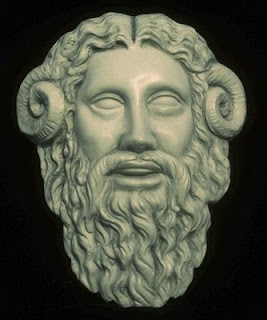 The hippocampi, as has already been discussed, are endowed with the task of binding elements of memory into a coherent trace. There are extensive interconnections within the hippocampi in the form of a local area network (LAN) or intranet. This LAN like architecture resembles the “Hopfield Network” of artificial neural networks. It is especially abundant in the CA3 neurones of the hippocampi. CA stands for Cornu Ammonis; meaning the horn of Ammon (After the ancient Egyptian God Amun).
The hippocampi, as has already been discussed, are endowed with the task of binding elements of memory into a coherent trace. There are extensive interconnections within the hippocampi in the form of a local area network (LAN) or intranet. This LAN like architecture resembles the “Hopfield Network” of artificial neural networks. It is especially abundant in the CA3 neurones of the hippocampi. CA stands for Cornu Ammonis; meaning the horn of Ammon (After the ancient Egyptian God Amun).In a Hopfield network, neurodes (neuronal equivalent of neurons) are connected to each other in the form of a bidirectional interconnection. However, a Hopfield network assumes that each neurode can have either of the two states: on (1) or off (0). But human neurons, we know, can also have additional states when it is in the summation or subtraction mode (spatial summation, temporal summation etc, whereby one neuron is incapable of eliciting a binary 1 or no action potential; but when suitably combined in a time [temporal scale] or a space scale [spatial], it can ). Reverberatory Hopfield networks reinforce each other, thereby strengthening the associations among themselves.
Earlier, mathematician cum scientist von Neumann tried to find an analogy between the memory architecture of a computer with that of a human brain. In a von Neumann architecture based computer, data can be fetched from their ‘address locations’ within the database when queried. Retrieval of data in a von Neumann model is sequential, that is the information flow is one by one. Human brain, on the other hand, handles data parallely, and there is no ‘bottleneck’ (which is inherent in the von Neumann model due to different locations of CPU and memory). No bottleneck means higher data transfer rate in the human brain. Human brains differ in another aspect. Secondly, human brain can think in terms of abstract terms, while a fixed program computer like von Neumann’s one, can not do so easily. In fact, human brain is far too superior in ‘fuzzy logic’ or abstract thinking compared to their silicon cousins.
The reverberatory circuit in the hippocampi is continuously synchronized with each input stimulus. This is akin to the synchronization of our circadian rhythms with that of daylight, via the retino-hypothalamic tract. The hippocampal anatomic correlate is somewhat like this: entorhinal cortex---> dentate gyrus---> CA1 & CA3 pyramidal neurons---> subiculum--> back to entorrhinal cortex. This circuit is heavily damaged in Alzheimer’s dementia resulting in loss of episodic memories and preventing acquisition of new memories. In artificial neural network model simulations, Traub and colleagues showed that the synchronization was done in the gamma frequency range. They showed that with the arrival of each theta cycle, the attractor-based autoassociative memory process got stronger and the attractor got stable after a few theta cycles. An attractor is somewhat like a binder, which indexes and binds information.
The hippocampi also get input from the basal ganglia and other portions of the brain. These regions have a diverse range of neurotransmitter chemicals. They include acetyl choline, GABA, NMDA, Dopamine, AMPA and many others.
In acetyl choline deprived state, as occurs in Alzheimer’s disease, the frequency of gamma
 discharge diminished, leading to diminution of theta frequency thus delaying learning (and promoting unlearning or unbinding too).
discharge diminished, leading to diminution of theta frequency thus delaying learning (and promoting unlearning or unbinding too).Its time to disentangle the intracytoplasmic neurofibrillary tangles; and clear the mystery of the amyloid plaques which are so characteristic of AD. The stage, it seems, has been set.
Reference: Attractor neural network models of spatial maps in hippocampus
Misha Tsodyks
Department of Neurobiology, Weizmann Institute of Science, Rehovot, Israel
2 comments:
I hardly leave comments, however i did some searching and wound up here "Neural Networking, Alzheimer's Disease and Memory Share a Few Things".
And I actually do have 2 questions for you if it's allright.
Could it be only me or does it look like some of these comments appear like they are written by brain dead people?
:-P And, if you are posting on other online social sites,
I'd like to keep up with everything new you have to post.
Could you make a list of the complete urls of your shared sites like your Facebook page, twitter feed, or linkedin profile?
my webpage - website, ,
While you forgot to give your webpage detail, here's what I found on some searching about these keywords:"I hardly leave comments, however i did some searching and wound up here"----"About 50,800 results (0.40 seconds)" in Google! That's what networking is all about!
Post a Comment